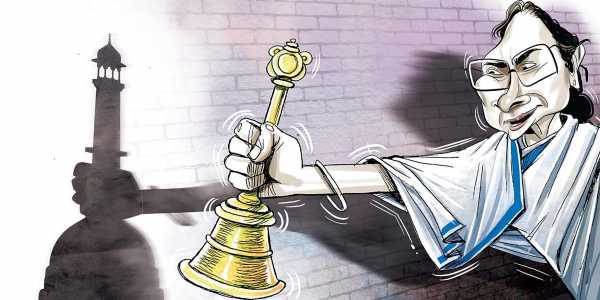
Like other ‘secular’ politicians, West Bengal’s chief minister hasn’t understood the difference between appeasement and empowerment
At an Eid celebration rally last week on Kolkata’s Red Road in front of a teeming crowd of over two lakh people, West Bengal Chief Minister Mamata Banerjee asked angrily: “Does loving Hindus mean you have to hate Muslims?”
She was reacting to charges of minority “appeasement” that have increasingly been levelled against her government. Banerjee’s speech was interesting for two reasons. First, she delivered it in Hindi, not Bengali, aiming her words therefore at a national audience. Second, in keeping with her growing national ambitions, she took pains to explain her politics to a wider Hindu audience not present at the event.
She said: “Many accuse me of Muslim appeasement. My question to them is whether loving Hindus means you have to hate Muslims? This is an insult to you. To all of us. This is an insult to humanity. This is an insult to justice. Those who say I appease Muslims are friends of neither Hindus nor Muslims. I go to mandirs, masjids, gurdwaras. I have done so from the beginning of my political life.”
Her political life is about to take a decisive turn. Banerjee is positioning herself as an alternative to both the BJP and the Congress. But to graduate from being a fiery regional satrap to a sober national leader she will need to learn from Prime Minister Narendra Modi who made that transformation successfully. He was a strong chief minister of Gujarat for over 12 years before leveraging a muscular Hindu nationalism to create a tsunami for the BJP in the 2014 Lok Sabha polls.
For Banerjee, the transformation will be far harder. Outside West Bengal, she is reviled as a politician who has allowed the state to descend into communal violence worse than anything seen even during the Left’s 34-year blood-soaked tenure. If Banerjee is to be a national leader, her self-styled secularism will come under close scrutiny. Like other ‘secular’ politicians, she woos Muslims by funding madrasas and mosques. She complains that others call this appeasement. But it is. Most politicians of her ilk haven’t understood the difference between appeasement and empowerment. Muslim leaders—political and religious—are complicit in this trickery. It suits them to keep the faithful appeased but not empowered.
Empowerment involves integrating Muslims into the mainstream, burnishing their talent, and using it to advance both their professional interests and national interest. Secular leaders have done the exact opposite. Muslims remain poor. They get low-paid jobs. They are discriminated against in housing and bank loans. The result: During the Congress’s decades-long rule at the Centre and states, Muslims have retreated to what are politely called community enclaves but in reality are ghettos where they seek safety and support from other Muslims. It is the single biggest disservice the Congress has inflicted on the community it professes to protect.
Can Banerjee overcome the secular trap? Can she empower Muslims? Banerjee sees an opportunity for herself in next year’s Lok Sabha election that could have shades of the 1996 general election. In 1991-96 the Narasimha Rao-led Congress had 250-odd seats in the Lok Sabha, not unlike the BJP today with just over 270 seats. In the 1996 Lok Sabha poll, the Congress’s tally slipped to 140 seats. The United Front government, comprising parties ranging from the Left to old-school socialists and led by Deve Gowda, cobbled together 192 seats. It was supported from the outside by the Congress with its 140 seats.
Banerjee hopes for something similar in 2019. She expects the BJP, confronted by straight fights in around 403 seats (her estimate) to fall below 150 Lok Sabha seats and a third front led by her to win at least 200 seats, triggering a 1996 redux with the Congress supporting her from outside.
Three assumptions underpin her calculations. One, Rahul Gandhi and Sonia Gandhi are so obsessed with defeating Narendra Modi that they will agree to contest only 250 out of 543 Lok Sabha seats in 2019 to give their regional allies a chance to checkmate the BJP in key states and boost the regional front’s tally to over 200 seats.
The second assumption is that rival leaders with national aspirations like Mayawati will play along. The BSP’s cooperation in states across northern and western India is crucial for Banerjee’s national project to succeed. The Samajwadi Party’s Akhilesh Yadav has agreed to give Mayawati 45 out of Uttar Pradesh’s 80 seats, keeping 35 for the SP and none at the moment for the Congress. After hard bargaining, the two fiefs of Rae Bareli and Amethi will obviously be ceded to the Gandhis but not much else.
The third assumption is the trickiest: the BJP may lose up to a total of 75 seats in Uttar Pradesh, Madhya Pradesh, Gujarat, Rajasthan, Chhattisgarh and a few other states but could make up over half that loss with gains in Odisha, the Northeast, West Bengal, Telangana and Andhra Pradesh. Confining thererby the net loss to 35-40 seats, the BJP could still sneak through with 240 seats. Disgruntled allies like the Shiv Sena, JD(U) and LJP, along with the Akalis and others, could make up the numbers.
Banerjee’s speech was an attempt to not only appeal to a national audience but also soften her pro-Muslim image. In West Bengal, where Muslims form nearly 30 per cent of the electorate, being pro-Muslim works. In India, it may not. Reading between the lines, Banerjee was at pains to define her version of secularism ahead of 2019: “I go to temples, masjids and gurudwaras,” she said, aiming her words at a wider national constituency.
Like other leaders who preach secularism and practise the opposite, Banerjee too has failed to bridge the divide between appeasing and empowering India’s minorities.
-Minhaz Merchant
The author is an editor and publisher
Courtesy: New Indian Express














